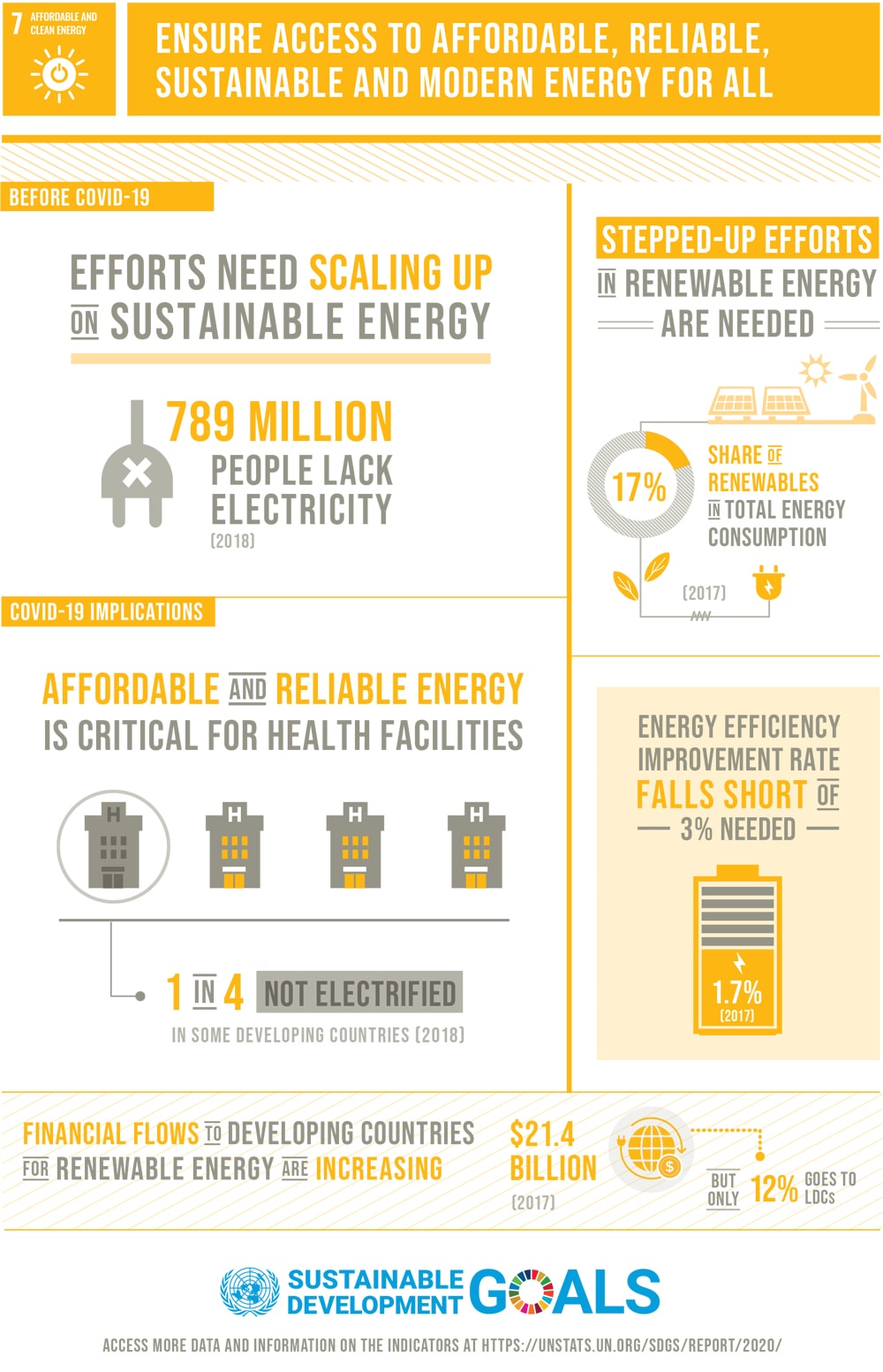Why is affordable and clean energy important
Energy is necessary in all facets of life, from the functioning of a human to functioning of a machine and ultimately for the functioning of an industry and a society. Energy in the current world is derived from various sources such as fossil fuels, electricity etc. for a wide range of purposes and activities.
Therefore a well established and managed energy generation and distribution system supports the various sectors of society, from business, agriculture, communication and technology, to education, medicine and infrastructure. So it is palpable as to the significance of energy for different sectors to run and function. However, the access to energy sources such as electricity is still lacking for remote areas. As per the Sustainable Development Goals Report-2020, 789 million people lack access to electricity.
There has been significant progress in increasing availability of electricity in poor countries along with energy efficient gains, with increasing emphasis placed on renewable energy. The latter is due to the adverse climatic effects and excessive costs incurred on the usage of coal, petrol and other fossil fuels for generation of electricity and other forms of energy. Considering the rapidly rising demand for electricity production and consumption, not finding alternate stable sources of generation would halt the powering of countries and cause negative adverse effects on the environment. UNDP also states that energy as a contributor to climate change accounts for 73% of anthropogenic based carbon emissions.
Therefore, as per the UNDP, there is a necessity for improvement in infrastructure and technology for provision of clean and efficient energy sources.

Understanding the root cause for inefficient and unaffordable energy
Lack of access to energy in a region arises from lack of sufficient infrastructure and technology. According to the Energy Progress Report, out of the 789 million people without access to electricity, 548 million belong to Sub-Saharan Africa. This region reflects the lack of necessary infrastructure due to the impoverished state of the economy which does not have sufficient scope to penetrate the society with energy related technologies.
As per the Sustainable Development Goals Report-2020, lack of access to electricity leads to a halt in the movement of water which forces women of remote areas to overlook employment and educational opportunities to fetch water. It slows down the production of goods and services, it adversely affects healthcare systems and it causes inconveniences in the education institutions.
The pandemic has further reiterated on the importance of a stable energy source, as electricity and other forms of energy are essential for the functioning of technology and devices that not only support the healthcare facilities but also assist the disaster management faculties in ultimately containing the virus.
Moreover, the increasing population and consequent growth in business, medicine, agriculture and education, among other things, leads to a greater demand for not only a stable reserve of energy but also a cheaper source of energy. Therefore there is a need to substantially increase the proportion of the global energy mix that renewable energy accounts for.
Changemakers working towards clean energy
Various organizations and government initiatives are working ardently towards energy conservation, efficiency, availability and alternatives. International Energy Agency (IEA) is an autonomous intergovernmental institution established by OECD which shapes energy policies for sustainable generation and consumption of energy. The International Renewable Energy Agency (IRENA) is another intergovernmental institution that promotes countries’ transition to sustainable forms of energy by providing mandated facilities and knowledge. Clean Energy States Alliance (CESA) is an alliance of states of the US wherein energy organizations of states form coalitions to promote and expand the scope and technologies of clean energy. International Solar Energy Society (ISES) engages in global partnerships for global alliance and strategic convention for promoting renewable forms of energy.
What youth can do as a TAL transformer
Participation of civil society institutions, private sector and government bodies is necessary to create joint effort and movement towards building energy efficient infrastructure and a network of access to all regions for the sake of sustainable and peaceful living.
What you as a transformer for the society can do, is use social advocacy, philanthropy and entrepreneurial/business ideas in an innovative manner to provide a progressive direction for reaching the goal. Instances of which are as follows:
Social Advocacy
- Promote commitment for sourcing from renewable energy for operational needs
- Promote domestic energy conservation and reduction of energy based carbon emissions
- Educate regarding clean energy sources
Social Philanthropy
- Invest in energy efficiency research and models
- Invest in renewable energy sources and services
- Invest in models of sustainable management of energy sources
Social Entrepreneurship
- Prioritize telecommunications in order to reduce internal transportations
- Incentivize energy solutions
- Technology for clean and green energy infrastructure
References
United Nations (2020). The Sustainable Development Goals Report 2020. New York: United Nations, Department of Economic and Social Affairs. Retrieved from https://unstats.un.org/sdgs/report/2020/
https://www.undp.org/sustainable-development-goals#affordable-and-clean-energy
https://trackingsdg7.esmap.org/
Sustainability Program Manager
